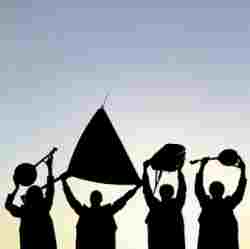
Andrei Konstantinov, soprano domara
Andrei Smirnov, bayan
Igor Ponomarenko, alto domra
Terem
Andrei Konstantinov, soprano domara
Andrei Smirnov, bayan
Igor Ponomarenko, alto domra
Program:
1. Lyrical Dance
2. Fantasy / I. Ponomarenko
3. The Legend of the Old Mountain Man / A. Golsky
4. Cossack's Farewell
5. Toccata / A. Repnikov
6. Variations on "Swan Lake" / P. Tchaikovsky
7. Simfonia Lubova / I. Ponomarenko
8. Old Carousel / V. Dimitriev
9. Two-step Nadya / A. Tsygankov
10. Tsiganka / A. Tsygankov
11. Letnie Kanikuli (Summer Vacation) / Miagava
12. Country Improvisation / I. Ponomarenko
13. Valenki / M. Shirokov
14. Barnynia / arr. M. Shirokov
total time: 39:00
released: 1992
label: Real World Records, A WOMAD Production
Marketed by Caroline Records Inc.
114 West 26th Street
New York, NY 10001
USA
Review by Dr. Rocco A. Jerry:
The Terem Quartet was formed by four students of the St. Petersburg Conservatory in 1986. They perform authentic Russian folk music with a fresh interpretation that is sometimes romantic, sometimes comedic, but always engaging. The domra is a 3 or 4 stringed bowl-backed instrument which is tuned similar to a mandolin. On Tracks 1 and 11 in particular, the lyrical use of the bayan (Russian button accordion) along with the repeated notes on the domras is not unlike the accordion/mandolin combination of the Mediterranean. The bass balalaika, a rather large 3-stringed triangular instrument, measures over four feet long. The bayan itself is a remarkable instrument; its right hand chromatic buttonboard has a range of approximately 7 1/2 octaves on some models (with appropriate stops).
The secret to the Terem's success is variety. Their music contains sharply contrasting fast and slow sections and abrupt dynamic changes. Both of these techniques tend to capture the attention of the listener and provide for interesting music. For instance, Track 1 opens with a slow romantic waltz which transforms into a march accompanied by dramatic staccato explosions on the accordion. To a listener unfamiliar with Russian folk music, the brief and unexpected interjections of singing/reciting on Tracks 2 and 13 may seem amusing. The foot stomping is appropriate for "Valenki" as the title refers to the special shoes worn in snow in rural areas of Russia.
In the title to Track 4, the Cossacks were a group living near the Don River in Russia who served as military guards. In return for their service, they enjoyed special priviledges which they ultimately lost during the Revolution. "Cossack's Farewell" is nostalgic, and opens with solo soprano domra. The alto domra gradually enters to form a duet. Later the accordion borrows the melody, and the piece closes in a sentimental vibrato.
Many of the tracks contain traditional Russian dances. For instance, "Barnynia" refers to a female owner of Russian peasants (a form of slavery which ended in 1861), and this dance was performed by these peasants. Track 10 is a Russian gypsy dance.
The arrangements provide a nice balance and interplay between the four instruments. In some of the very rapid legato passages of Tracks 2 and 7, the bayan is not as clear as it could be. Nonetheless, throughout the CD the bayan carries much of the melodic material and is sensitively performed. Some non-traditional techniques are very effectively used in the opening of Track 11.
The composer of "Toccata", Albin Repnikov, is known for writing both classical and folk music, and for blending the lines between the two. This particular piece is much more folk music-oriented than what the title suggests.
It is clear that the performers had fun producing this CD. Their music would probably be appreciated not only by folk and world music fans, but also by others interested in hearing enthusiastically-performed music by an unusual instrumental combination.
| About The Free-Reed Review |
| Invitation to Contributors / Submission Guidelines |
| Back to The Free-Reed Review Contents
Page |
| Back
to The Classical Free-Reed, Inc. Home Page |